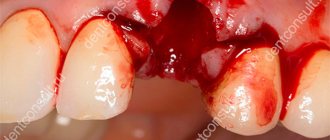From the moment they appear, wisdom teeth often behave unpredictably, grow slowly and crookedly, and the growth process is accompanied by pronounced symptoms. Taking into account such features, it is considered quite natural that the wound bleeds after extraction of the “eight”. In this case, intermittent hemorrhages, which last up to 2-3 days and no more, are considered the norm. They are caused by damage to the periosteum and soft tissues during tooth extraction. When blood is released longer and negative symptoms are observed, then you definitely need to see a dentist to find out the cause of the incessant bleeding.
Causes of bleeding
As a rule, hemorrhage (hemorrhage) occurs as a response to damage during soft tissue surgery or as a result of exposure to certain medications. Such problems usually go away within a few hours after the procedure.
If an ordinary tooth can be pulled out without much difficulty and a cotton swab applied to the wound, then removing third molars is much more difficult. During the manipulation process, it is often necessary to saw the crown of the tooth and pull it out in parts. With deep and curved roots, it is almost impossible to extract them without damaging bone and soft tissue.
In addition, there are also other reasons why the bleeding does not stop after a wisdom tooth has been removed:
- high blood pressure;
- mechanical injuries of a large vessel;
- the patient is taking blood thinning medications, for example, Heparin, Aspirin and others;
- low blood clotting;
- the use of anesthetics, after which the blood vessels dilate. This increases bleeding and slows down the process of clot formation;
- the presence of concomitant diseases can cause heavy bleeding. These include hepatitis, scarlet fever, leukemia, hemophilia and others;
- Overheating of the body or high physical activity immediately after removal increases the risk of hemorrhage.
If immediately in the postoperative period the patient abuses alcoholic beverages or smoking, bleeding can occur as complications.
If wisdom tooth extraction cannot be avoided, then the patient needs to understand that bleeding after such a procedure is a natural and normal process. But even with relative safety, the release of blood requires careful monitoring by both the doctor and the patient himself.
Causes
After surgery, the human body needs time to recover and stop bleeding. On average, the duration of the pathological condition is 30 minutes. But in some cases it may take much longer to stop the bleeding.
Inflammatory processes, hypotension, blood clotting disorders, suppuration of the socket, tissue injury during surgery, and patient errors during the rehabilitation period can contribute to the appearance of bleeding after wisdom tooth removal.
Bleeding is stopped by suturing the wound, taking anti-inflammatory, antihistamine, antibacterial drugs, and using electrocoagulation.
A common situation is the continuous process of bleeding from the socket. Pathology occurs due to the physiological structure of the element; soft tissues surrounding it; non-compliance with measures prescribed by a specialist. Less commonly, the problem arises due to unprofessional actions of the surgeon.
In the first two days after wisdom tooth extraction, it is strictly forbidden to rinse the mouth vigorously. This can lead to the detachment of the healing thrombus from the bottom of the socket and the resumption of intense bleeding.
Dentist
Novikova Olga Alexandrovna
8 years of experience
There are several common causes of prolonged bleeding.
Hypotension
Removing wisdom itch for a person with high blood pressure occurs according to a special scheme. However, even these measures do not provide a 100% guarantee against the problem. After surgery, a person suffering from hypotension remains under the supervision of a doctor for several hours.
The pathology may appear several hours or even days after tooth extraction due to the patient’s strong emotional experience or other negative factors. In this situation, a scheme to combat the abnormal condition is prescribed not only by the dentist, but also by the therapist.
Slow blood clotting
Such patients are considered a risk group, and surgery is performed for them only after undergoing a set of diagnostic measures.
Erroneous actions during the rehabilitation period
After removing a wisdom tooth, surgeons give the patient a number of recommendations that he will have to follow when he comes home. These include:
- refusal to eat food for several hours after the intervention;
- temporary exclusion of physical activity;
- treating the affected area with antiseptic solutions.
Inflammation of soft tissues at the site of an extracted tooth
After the intervention, the hole is covered with several layers of antimicrobial agents. These measures are performed to prevent infection from entering the open cavity.
Despite careful processing, the risk of infection exists. One of the manifestations of the onset of the infectious process is prolonged bleeding.
Decay of the socket cavity
Specialists are not always able to conduct the necessary research before removing a wisdom tooth, since patients often seek help with unbearable pain. The cause of this condition may be an infectious process in the dental tissues, when removed, pathogenic microorganisms enter the bloodstream and spread throughout the body.
During urgent operations, the surgeon may not notice granulomas or abscesses that have formed near the wisdom tooth. All these purulent formations negatively affect the formation of a blood clot and lead to severe bleeding.
Severe soft tissue damage during surgery
If blood vessels were damaged during tooth extraction, the patient will experience heavy blood loss after surgery.
Duration of bleeding, normal limits
One of the frequently asked questions by patients who are about to have a wisdom tooth removed is how long does the formed socket bleed and what to do if the bleeding does not stop.
As a rule, after 10-15 minutes after surgery, a blood clot forms in the socket; in some patients, approximately 30-40 minutes may pass before the clot appears. Under no circumstances should this clot be removed, because it protects the wound from infection.
Deviations from the norm are situations where bleeding continues after returning home. But some patients worry in vain, mistaking ichor for blood. If the bleeding in most cases stops within 30-60 minutes, then the discharge of ichor from the wound can be observed for up to 12 hours or longer.
Ichor is a yellowish or colorless liquid with a small blood capacity. Each person may have a different intensity of discharge depending on the characteristics of the body, but in any case this is not a cause for concern.
If blood is released from the wound uncontrollably for a long time, you should inform the doctor about this without waiting for complications.
Why doesn't the bleeding stop?
Depending on the physiological characteristics of the body, in some patients a clot forms immediately after surgery, in others the bleeding does not stop for a long time. The reasons for this condition may be different.
High blood pressure
A patient with hypertensive pathology often experiences bleeding from the socket, so if he has such a disease, he should inform the doctor about it before the operation. This will allow you to find an individual approach to a problem patient and prevent possible complications.
Poor blood clotting
If the patient has previously been diagnosed with coagulation disorders, then he is obliged to inform the doctor about the existing problems in order to prevent negative consequences.
Inflammation of the socket
After surgery, the doctor must treat the hole with an antiseptic. But even treatment is not always a guarantee that the bleeding will stop after wisdom teeth are removed. If the socket is a source of infection, the gums usually bleed. In such cases, you should not resort to self-medication, as this can lead to dire consequences. Only a professional specialist can correctly diagnose and prescribe effective treatment.
Purulent accumulations
Before performing any manipulation, the dentist must diagnose the patient’s jaw and make sure there are no pathologies. If there are already purulent accumulations inside the gums, this can provoke heavy bleeding, which is quite difficult to stop.
Damage to the integrity of blood vessels
Due to the irregular growth and location of wisdom teeth in hard-to-reach areas of the oral cavity, the removal of such units is considered a relatively complex dental procedure. Vessels are almost always damaged by surgical instruments. Usually, after several hours, the bleeding stops, but the patient may simply not feel pain due to prolonged exposure to the anesthetic. If large vessels are damaged during surgery, bleeding may occur later and in such cases you should not hesitate to visit the dentist.
Failure to comply with medical recommendations
A rather complex procedure is the removal of a wisdom tooth; bleeding can occur in every patient, even if the operation is performed correctly. The reason for this is improper wound care, which leads to a deterioration in the condition of the hole and the development of an inflammatory process.
How to stop bleeding
Many patients simply do not understand the complexity of wisdom tooth extraction and when bleeding occurs after the procedure, they do not know how to stop the bleeding. If blood leaks from the gums within a few hours, you can consult a dentist or try to stop it yourself at home.
First aid with gauze swabs
Immediately after pulling out a tooth, the dentist washes the hole, treats it with an antiseptic solution and applies a gauze swab. After 15 minutes you need to spit it out. If this is not done, then after half an hour bacteria will multiply in the blood accumulated on the tampon, and this increases the risk of the inflammatory process.
If bleeding continues after spitting out the tampon, you should make a new tampon from a sterile bandage or gauze, apply it to the gums, firmly clamp your teeth and hold for about 20 minutes. If blood continues to accumulate in the oral cavity, then the procedure with a tampon can be repeated, only now it needs to be slightly moistened in a solution of Miramistin or hydrogen peroxide.
Home Remedies
the blood does not stop after the wisdom tooth is removed by the dentist , then you can use a cold compress. You need to apply a bottle of cold water or a piece of ice wrapped in a cloth to your cheek for a few minutes. Cold relieves pain well, reduces swelling and promotes the rapid formation of a blood clot.
Tea leaves have good tanning properties. To stop bleeding, you can apply a pre-wetted and cooled black tea bag to the place where the tooth was pulled out for 10 minutes. Just don’t apply a hot bag, as the clot that has already formed may melt.
Medications
When the gums bleed after tooth extraction, it is worth purchasing hemostatic drugs at the pharmacy, for example, Dicynon or Etamzilat. The tablets begin to act within 20 minutes after taking them, but the full effect is observed after several hours.
If you experience severe pain, you can take a painkiller. If, after visiting a doctor, an inflammatory process is diagnosed, then a course of antibiotics cannot be avoided; only a specialist must prescribe a specific drug.
In order not to irritate the gums even more, special hemostatic sponges can be applied to the wound. They perfectly normalize coagulation, have an antimicrobial effect and stop bleeding.
What to do
If a problem arises, a person can help himself at home. It is important not to spit out the tampon applied to the tooth extraction site for 20 minutes. This time is enough for the formation of a thrombus - a blood clot that prevents further loss.
If the problem remains unresolved, then a hemostatic sponge can be applied to the place of the removed wisdom tooth. If there is no improvement, you should see a doctor who will stitch the wound.
Blood can be established at home using the following steps:
- applying a clean cotton or bandage swab to the affected area;
- stabilization of morale and adoption of a sitting or lying position;
- taking a special medication if a person suffers from high blood pressure;
- application of dry cold to the cheek from the side of the pulled out tooth.
Is it painful to have wisdom teeth removed?
A person has 32 teeth, four of them are called wisdom teeth.
If there is a blood clot, an ice compress will help to have several effects on the affected area of the gum:
- reduce bleeding at the site of the extracted wisdom tooth;
- allow the clot to cover the entire surface of the wound;
- protect the cavity from the introduction of pathogenic flora;
- reduce swelling of the cheek and soft tissues;
- dull pain after anesthesia.
If after 30-40 minutes it was not possible to stop the bleeding, then a new tampon soaked in a solution of hydrogen peroxide (3%) is applied to the hole.
If weakness, dizziness and other signs occur, you must urgently call an ambulance. Before doctors arrive, the patient is recommended to spit the resulting blood into a container so that specialists can assess the intensity of the problem.
At the clinic, the doctor will take professional steps to stop the bleeding. The method of treatment will depend on the cause of the pathological condition. For patients with hypertension, tampons moistened with hemostatic drugs - Kollapan, Iodoform, Dimexide - are applied to the damaged area.
Actions after surgery
To prevent hemorrhage and other negative consequences after the removal of a wisdom tooth, the following manipulations are performed directly in the dentist’s office:
- the alveolar socket is cleaned;
- the doctor examines the wound for any remaining tooth fragments;
- damaged tissues are treated with antiseptic agents;
- a tampon is applied.
If bleeding continues after 15-20 minutes, the doctor can inject hemostatic solutions, if large vessels are damaged, bandage them, apply hemostatic agents (fibrin film, sponge, aminocaproic acid, etc.), apply sutures or perform electrocoagulation (cauterization of blood vessels) .
Content:
- How long does it take to bleed after tooth extraction?
- Why is it important how long it takes to bleed after tooth extraction?
- Types of violation
- Why does it take a long time to bleed after extraction?
- Possible consequences of bleeding
Extraction is one of the most difficult operations performed by dental surgeons. During the recovery period after it, serious complications may develop, one of them is bleeding. Therefore, the gum healing process requires close monitoring by the doctor and vigilance of the patient himself.
Complications after wisdom tooth removal
Manipulations for the extraction of wisdom teeth should not be underestimated, since even if such procedures are carried out correctly, the patient may experience complications.
Edema
One of the most common consequences that occurs after tooth extraction is swelling. The reason for this may be partial damage to the tissues around the tooth. Usually the swelling goes away within 1-2 days. To speed up the elimination of swelling, this can be done by applying cold compresses to the cheek.
Fever
After a tooth is removed, the body’s natural reaction is to increase body temperature. This condition can last for 2-3 days. To improve your health, you need to take antipyretic drugs, but if the condition does not improve, you should immediately visit a doctor.
Soreness
Pain after extraction of the “eight” occurs due to damage to the periodontal tissues and nerves. If the pain cannot be tolerated, then for relief you need to take analgesics. When painkillers do not help, you should go to the dentist.
Suppuration of the socket
If the wound becomes infected, suppuration may occur. The reasons for the formation of pus may be non-compliance with medical recommendations and improper care of the oral cavity, as well as dental fragments remaining in the tissues after surgery. Self-medication in such cases is inappropriate; only a qualified doctor can prescribe adequate treatment and eliminate the cause of suppuration.
Dry socket
The blood clot must remain in the wound. It protects nerve endings and bone from microbial penetration. Therefore, on the first day after the manipulation, you should not rinse your mouth, and also do not eat hot food.
If a dry socket forms, this leads to increased pain, inflammation and alveolitis. In such cases, the doctor places a tampon with anti-inflammatory gel on the sore spot. Treatment continues until complete healing.
When should you see a doctor?
In most cases, bleeding can be stopped using simple measures, but sometimes it requires immediate consultation with a doctor. You need to contact an emergency dental clinic if:
- the blood flows too intensely (the oral cavity fills with blood literally every few seconds);
- along with bleeding, a person experiences weakness and dizziness;
- the affected area is very swollen and painful;
- bleeding is accompanied by fever, difficulty breathing or swallowing;
- the patient experiences a severe headache and numbness in the areas adjacent to the affected area.
Phlegmon - acute extensive (spread) inflammation of fatty tissue
A variant of the norm is considered to be mild or moderate bleeding, which lasts no more than 24 hours; after the removal of third molars, this period increases to three days.
Photo of holes after tooth extraction
Precautionary measures
A wisdom tooth has been removed and the wound is bleeding – what to do in such situations? Hemorrhagic syndrome can be prevented with the help of hemostatic drugs, provided there are no contraindications.
In the first days after the manipulation, you need to brush your teeth with extreme caution and do not eat hot or hard foods. You should not stick your tongue into the hole, as such actions can damage the clot.
You should also avoid physical activity, visit the sauna, and take hot baths.
Before the procedure, you need to accurately and truthfully answer all questions asked by the doctor, especially about taking anticoagulants, aspirin and the presence of pathogenic diseases. Women do not need to hide the presence of menstruation and the use of contraceptives.
If you have high blood pressure or problems with blood clotting, you must notify your dentist.
In what cases should you seek medical help?
You should seek dental help after removing a figure eight in the following cases:
- with constant bleeding, the abundance of which does not decrease;
- with dizziness, severe headache and weakness;
- with sharp and severe pain in the gum area;
- with bloody discharge mixed with pus;
- when the elevated temperature persists for several days.
Swelling and swelling after the procedure are not a cause for concern. But when such swelling does not go away, then for your own safety it is better to visit the clinic as soon as possible.
Why does it take a long time to bleed after extraction?
The reasons may be different, there are many of them. The most common:
- A sharp increase in blood pressure. Occurs in response to stress experienced during dental surgery.
- Vascular injuries. It is impossible to remove a unit without damaging them.
- Hormonal imbalance or increased levels of estrogen in the body. This reason only applies to women.
- Taking medications containing acetylsalicylic acid on the eve of a visit to the dentist. Aspirin helps thin the blood and prevents its rapid clotting. Some other medications work similarly. Therefore, it is important to be cautious about using any medications in the days leading up to the extraction.
- Gum injuries. The patient himself is usually to blame. The desire to touch the blood clot with your hands, tongue, eating too hard foods and chewing them on the inflamed side of the jaw, rinsing the mouth, drinking hot drinks or dishes are all causes of postoperative bleeding.
The wound heals worse if the gum in the area of the extracted tooth has been affected by gumboil or a cyst. In this case, the patient should be constantly monitored. Most likely, he will have to take anti-inflammatory drugs, antibiotics, and applications with antibacterial compounds for some time.
Anemia, hemophilia, alcoholism, diabetes mellitus, and atherosclerosis also increase the likelihood of postoperative complications. You must inform your doctor about the presence of these diseases. It is possible that he will prescribe hemostatic drugs.
Professional assistance at the Berezka clinic
A dentist in a clinical setting stops bleeding in several ways, depending on the severity of the condition and the individual characteristics of the patient. It should be noted that each of the methods will be effective only if you seek medical help in a timely manner.
Stitching
The damaged vessel is ligated over the hole or soft tissue is sutured. The boas of the method stop bleeding with equal effectiveness.
Electrocoagulation
The manipulation is performed under local anesthesia. They resort to this procedure if several capillaries are damaged. The tissues are dissected using a special tool, after which they are soldered, facilitating rapid healing of the wound.
Application of fibrin film
A fibrin film is applied to the place where the tooth was removed. In addition to the hemostatic effect, the film also has an anti-inflammatory, disinfecting and healing effect.
Tamponation
In this case, the dentist uses iodoform turunda. It is inserted into the hole in the same way as a gauze swab, but to a greater depth.
Hemostatic tube
The method is relevant for patients suffering from high blood pressure. The tube is carefully inserted into the hole and held until the AT is brought back to normal.
You can also use gelatin and collagen sponges to stop bleeding.
The dentist makes a decision on the need for additional treatment procedures based on the results of examining the condition of the wound after extraction.
Benefits of wisdom teeth removal at Beryozka
If you need to extract a wisdom tooth in Balashikha, we invite you to carry out such a procedure at the Beryozka clinic. Advantages of our dentists' services:
- absolute painlessness and speed of manipulation are ensured by the professionalism and experience of dental surgeons;
- During surgical interventions, the clinic’s specialists use modern anesthetics;
- minimal trauma is achieved through the use of advanced technologies during operations, which prevents bleeding and promotes rapid healing of the wound surface.
Our clinic offers an objectively affordable cost for figure eight removal and each patient receives effective dental care.










